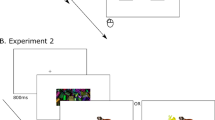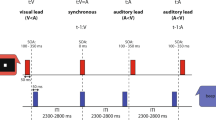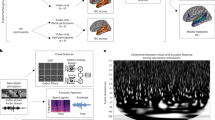Abstract
Little is known about how the brain binds together signals from multiple sensory modalities to produce unified percepts of objects and events in the external world. Using event-related functional magnetic resonance imaging (fMRI) in humans, we measured transient brain responses to auditory/visual binding, as evidenced by a sound-induced change in visual motion perception. Identical auditory and visual stimuli were presented in all trials, but in some trials they were perceived to be bound together and in others they were perceived as unbound unimodal events. Cross-modal binding was associated with higher activity in multimodal areas, but lower activity in predominantly unimodal areas. This activation pattern suggests that a reciprocal and 'competitive' interaction between multimodal and unimodal areas underlies the perceptual interpretation of simultaneous signals from multiple sensory modalities.
This is a preview of subscription content, access via your institution
Access options
Subscribe to this journal
Receive 12 print issues and online access
$209.00 per year
only $17.42 per issue
Buy this article
- Purchase on Springer Link
- Instant access to full article PDF
Prices may be subject to local taxes which are calculated during checkout



Similar content being viewed by others
References
Morrell, L.K. Temporal characteristics of sensory interaction in choice reaction times. J. Exp. Psychol. 77, 14–18 (1968).
McGurk, H. & MacDonald, J. Hearing lips and seeing voices. Nature 264, 746–748 (1976).
Driver, J. Enhancement of selective listening by illusory mislocation of speech sounds due to lip-reading. Nature 381, 66–68 (1996).
Sekuler, R., Sekuler, A.B. & Lau, R. Sound alters visual motion perception [letter]. Nature 385, 308 (1997).
Stein, B.E. Neural mechanisms for synthesizing sensory information and producing adaptive behaviors. Exp. Brain Res. 123, 124–135 (1998).
Fuster, J.M., Bodner, M. & Kroger, J.K. Cross-modal and cross-temporal association in neurons of frontal cortex. Nature 405, 347–351 (2000).
Macaluso, E., Frith, C.D. & Driver, J. Modulation of human visual cortex by cross-modal spatial attention. Science 289, 1206–1208 (2000).
Calvert, G.A., Hansen, P.C., Iversen, S.D. & Brammer, M.J. Detection of audio-visual integration sites in humans by application of electrophysiological criteria to the bold effect. Neuroimage 14, 427–438 (2001).
Bushara, K.O., Grafman, J. & Hallett, M. Neural correlates of auditory-visual stimulus onset asynchrony detection. J. Neurosci. 21, 300–304 (2001).
Watson, J.D. et al. Area V5 of the human brain: evidence from a combined study using positron emission tomography and magnetic resonance imaging. Cereb. Cortex 3, 79–94 (1993).
Fletcher, P.C. et al. The mind's eye—precuneus activation in memory-related imagery. Neuroimage 2, 195–200 (1995).
Alho, K., Woods, D.L. & Algazi, A. Processing of auditory stimuli during auditory and visual attention as revealed by event-related potentials. Psychophysiology 31, 469–479 (1994).
Spence, C., Nicholls, M.E. & Driver, J. The cost of expecting events in the wrong sensory modality. Percept. Psychophys. 63, 330–336 (2001).
van Gelderen, P. et al. Three-dimensional functional magnetic resonance imaging of human brain on a clinical 1.5-T scanner. Proc. Natl. Acad. Sci. USA 92, 6906–6910 (1995).
Josephs, O. & Henson, R.N. Event-related functional magnetic resonance imaging: modelling, inference and optimization. Philos. Trans. R. Soc. Lond. B Biol. Sci. 354, 1215–1228 (1999).
Friston, K.J. et al. Event-related fMRI: characterizing differential responses. Neuroimage 7, 30–40 (1998).
Acknowledgements
We thank J. Rauschecker for comments on the manuscript, D.G. Schoenberg for editing the manuscript, and N. Dang, P. van Gelderen and H. Shill for their assistance. Supported by the National Institute of Neurological Disorders and Stroke and the Department of Veterans Affairs.
Author information
Authors and Affiliations
Corresponding author
Ethics declarations
Competing interests
The authors declare no competing financial interests.
Rights and permissions
About this article
Cite this article
Bushara, K., Hanakawa, T., Immisch, I. et al. Neural correlates of cross-modal binding. Nat Neurosci 6, 190–195 (2003). https://doi.org/10.1038/nn993
Received:
Accepted:
Published:
Issue Date:
DOI: https://doi.org/10.1038/nn993
This article is cited by
-
Multisensory synchrony of contextual boundaries affects temporal order memory, but not encoding or recognition
Psychological Research (2023)
-
EEG-based analysis of various sensory stimulation effects to reduce visually induced motion sickness in virtual reality
Scientific Reports (2022)
-
Shared neural representations of tactile roughness intensities by somatosensation and touch observation using an associative learning method
Scientific Reports (2019)
-
The rubber hand illusion induced by visual-thermal stimulation
Scientific Reports (2018)
-
Arousing emoticons edit stream/bounce perception of objects moving past each other
Scientific Reports (2018)



